
The Lady of Stavoren (Dutch: Vrouwtje van Stavoren, West Frisian: Frouke fan Starum) is a folk tale from the Netherlands which originated in the 16th century.

The Lady of Stavoren (Dutch: Vrouwtje van Stavoren, West Frisian: Frouke fan Starum) is a folk tale from the Netherlands which originated in the 16th century.
Now a village of just 1,000 inhabitants, Stavoren was once a wealthy port city in the Dutch province of Friesland but began to decline in the late Middle Ages after a sandbank formed outside the harbour, blocking ships from entering and exiting. Several stories have been told over the years to explain the forming of the sandbank, including the tale of the Lady of Stavoren.
The story, of which more than 27 versions are known, involves an exceedingly rich patrician merchant widow, who desired ever greater riches. She sent a captain of her merchant fleet out in search of the greatest treasure in the world. When he returned with wheat, declaring wheat to be "the most precious thing in the world," as it can feed the hungry, the widow, in her overweening pride and anger at his (as she perceived it) foolishness, let the wheat be thrown overboard into the harbour of Stavoren.
When she was cautioned against this wicked behaviour, being reminded of the fickleness of fate and (despite her wealth and power) of the delicateness of her station, in hubris she took a ring from her finger and cast it into the ocean, declaring that she was as likely to fall into poverty as she was of regaining the ring.
Soon afterwards, during a banquet thrown for her fellow Hanseatic merchant princes, she finds the ring inside a large fish served to her. As this event portended, she lost her wealth, living out her remaining years in destitution, begging for scraps of bread. In divine retribution the port had silted, and the wheat that had been cast overboard now grew in the resulting sandbank that closed the harbour and ruined the city.
The tale shares its basic motif with the story of the Ring of Polycrates found in Herodotus. [1] Its Aarne-Thompson index number is 736A. The Lady made her first entrance in the Friesland Chronicle of Ocko Scarlensis (1597) and the story was gradually elaborated thereafter. The sandbar on which only empty ears of wheat will grow was added in the eighteenth century, while the motif of the discarded ring appears for the first time around 1810. [2]
The tale has inspired songs, plays, operas and films. A statue of the fabled Lady gazing out to sea was erected in front of Stavoren harbour in 1969.

Stavoren is a city in the province of Friesland, Netherlands, on the coast of the IJsselmeer, about 5 km south of Hindeloopen, in the municipality of Súdwest-Fryslân.
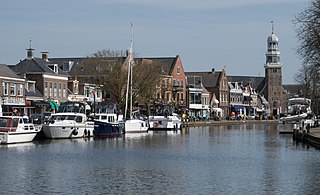
Lemmer is a town in the municipality of De Fryske Marren, in the Dutch province of Friesland. Lemmer lies adjacent to the IJsselmeer and the Frisian Lakes and is one of Friesland's best-known surface water sports locations. Lemmer is a bustling lakeside resort in the summer months and attracts not only day-trippers from surrounding communities such as Emmeloord, Urk, and Joure, but also national and international tourists.
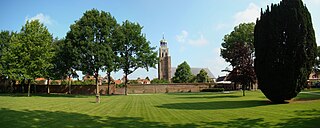
Vollenhove is a city in the Dutch province of Overijssel. It is located in the municipality of Steenwijkerland, southwest of Steenwijk. Until the Noordoostpolder was drained, it was located on the coast of the Zuiderzee.

The loathly lady, is a tale type commonly used in medieval literature, most famously in Geoffrey Chaucer's The Wife of Bath's Tale. The motif is that of a woman who appears unattractive but undergoes a transformation upon being approached by a man in spite of her unattractiveness, becoming extremely desirable. It is then revealed that her ugliness was the result of a curse which was broken by the hero's action.

Atje Keulen-Deelstra was a Dutch speed skater, who was a four-time World Allround Champion between the age of 32 and 36.

Sjoukje Maria Diderika Troelstra-Bokma de Boer, better known under her pseudonym Nienke van Hichtum, was a well-known Frisian Dutch children's author and translator. From 1888 to 1904, she was married to the socialist leader Pieter Jelles Troelstra. The couple had two children: a daughter, Dieuwke and a son, Jelle. Her son Jelle Troelstra (1891–1979) was a sculptor and graphic designer.

"Hind Horn" is a traditional English and Scottish folk ballad.
"The Fish and the Ring" is an English fairy tale collected by Joseph Jacobs in English Fairy Tales. This tale has several parallels in the literature and folklore of various cultures.
The Three Dogs is a German fairy tale. Andrew Lang included it in The Green Fairy Book, listing his source as the Brothers Grimm. A version of this tale appears in A Book of Dragons by Ruth Manning-Sanders.
No Wit, No Help Like a Woman's is a Jacobean tragicomic play by Thomas Middleton.

Folklore of the Low Countries, often just referred to as Dutch folklore, includes the epics, legends, fairy tales and oral traditions of the people of Belgium, Netherlands and Luxembourg. Traditionally this folklore is written or spoken in Dutch or in one of the regional languages of these countries.
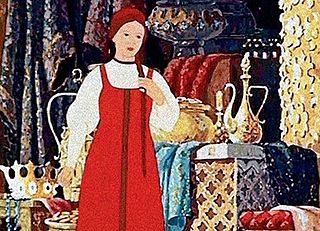
The Scarlet Flower is a 1952 Soviet feature animated film directed by Lev Atamanov. It was produced at the Soyuzmultfilm studio in Moscow and is based on the story of the same name by Sergei Aksakov. Nastenka's song "During this time in a darling party"/"В эту пору в родимой сторонушке" was sung by the famous chamber singer Victoria Ivanova.

Museum Geelvinck Hinlopen Huis was situated from its opening 1991 till the end of 2015 in a canal-side mansion, the Geelvinck Hinlopen Huis in Amsterdam, the Netherlands. This patrician mansion, close to the Rembrandtplein, was built for Albert Geelvinck (1647-1693) and Sara Hinlopen (1660-1749), then in an attractive and new laid-out section of the city towards the Amstel. In the year 1687 the couple moved into this double wide house, with storage rooms in the cellar, under the attic and in the warehouse on Keizersgracht 633, now the entrance.

Lucia Wijbrants or Wybrants was the daughter of Johannes Wijbrants, a silk merchant, whose ancestors had moved from Stavoren to Antwerp. After 1585 when Antwerp was occupied by the Spanish army, the family moved to Amsterdam and lived in a house in the Warmoesstraat, then a fashionable shopping street. They had eight more children: only Hendrick (1623–1669), Helena (1628–1721), and Johannes survived.

Hellawes the sorceress is a character in Thomas Malory's 15th-century Arthurian legend compilation Le Morte d'Arthur. She is lady of the Castle Nygurmous, associated with the chapel perilous episode in one of the quests of Lancelot.
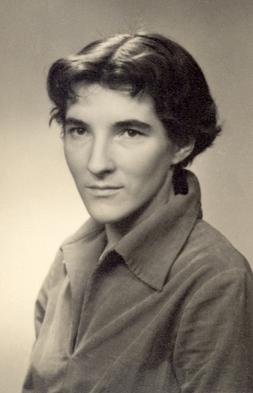
Hanneke Eikema was a Dutch woman who, during World War II, helped ferry Jewish children to safety and assisted in the financial logistics of the Dutch resistance.

Justus Hiddes Halbertsma, West Frisian form: Joast Hiddes Halbertsma, pron. [jo.ǝst ˈhɪdəs ˈhɔlbǝtsma] ; Dutch form: Joost Hiddes Halbertsma, pron. [joːst ˈhɪdəs ˈhalbǝrtsma], was a Frisian writer, poet, minister, lexicographer and linguist. Today, he is primarily known for the poetry and short story collection De Lapekoer fan Gabe Skroar, which he wrote with his brother Eeltsje, publishing the first edition in 1822. Afterwards, this work was continually expanded, and also came to include contributions by a third brother, Tsjalling, until all the Halbertsma Brothers' prose and poetry was posthumously collected in 1871 to become the famous work Rimen en Teltsjes. Although the literary value of this collection was later disputed by some critics, it is undeniable that Rimen en Teltsjes played a role of crucial importance in the development of a new literary tradition after Western Frisian had been used almost exclusively as a spoken language for three centuries.
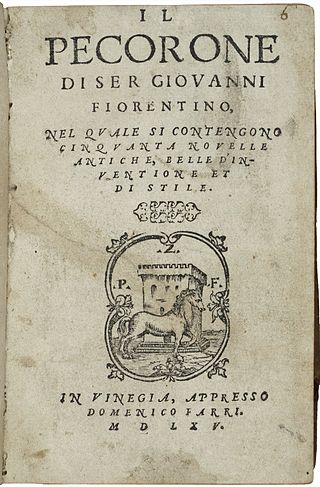
Il Pecorone, often referred to in English as The Golden Eagle, is an Italian novela written between 1378 and 1385 by Giovanni Fiorentino. It was written in a style influenced by the Decameron of Giovanni Boccaccio, the Golden Legend collection of saint lives, the Seven Sages of Rome or the Gemma ecclesiastica of Giraldus Cambrensis. For its historical facts, however, it relies on the Nuova Cronica of Giovanni Villani.

Lauwersoog is a seaside village and harbour in the province of Groningen, located in the northern part of the Netherlands. It is part of the municipality of Het Hogeland. It was established on 23 May 1969. The ferry to Schiermonnikoog departs from Lauwersoog.
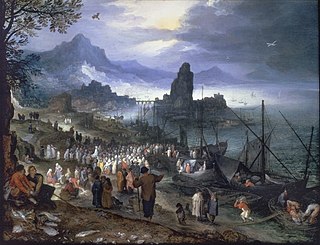
The Sermon on the Sea of Galilee is a painting by the Flemish painter Jan Breughel the Elder. It was painted in 1597. Its current whereabouts are unknown.